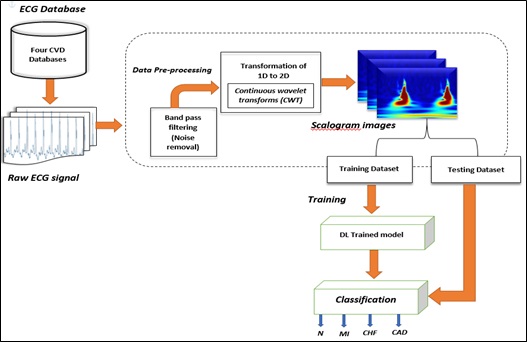Adapting Transfer Learning for Accurate ECG Based Heart Disease Classification
Keywords:
Cardiac Heart Disease, Electrocardiogram, Convolution Neural Network, Transfer Learning.Abstract
ECG signals are widely used for analyzing heart rhythms and detecting abnormalities. This study presents an experimental evaluation of a Deep CNN model for classifying ECG scalograms. Using publicly available datasets containing records from 242 patients, the study aims to classify three different cardiovascular diseases: Congestive Heart Failure (CHF), Myocardial Infarction (MI), and Coronary Artery Disease (CAD). The raw ECG signals undergo several preprocessing steps, including up-sampling, removal of noise and artifacts, and conversion into 2D images. Continuous Wavelet Transform (CWT) is applied to represent the ECG signals as 2D scalograms. The experiments in this work are conducted using a Deep CNN model and the pre-trained Inception V3 model, which achieved accuracies of 96.87% and 90.11%, respectively, on the CWT scalograms of the ECG datasets. The results were thoroughly analyzed, and the model’s performance was compared with other existing studies in the field.
References
Denysyuk, H.V., et al., Algorithms for automated diagnosis of cardiovascular diseases based on ECG data: A comprehensive systematic review. Heliyon, 2023.
Wang, Z., S. Stavrakis, and B. Yao, Hierarchical deep learning with Generative Adversarial Network for automatic cardiac diagnosis from ECG signals. Computers in Biology and Medicine, 2023. 155: p. 106641.
Islam, M.R. and M. Nahiduzzaman, Complex features extraction with deep learning model for the detection of COVID19 from CT scan images using ensemble based machine learning approach. Expert Systems with Applications, 2022. 195: p. 116554.
Ma, K., A.Z. Chang'an, and F. Yang, Multi-classification of arrhythmias using ResNet with CBAM on CWGAN-GP augmented ECG Gramian Angular Summation Field. Biomedical Signal Processing and Control, 2022. 77: p. 103684.
Lu, X., et al., An end-to-end model for ECG signals classification based on residual attention network. Biomedical Signal Processing and Control, 2023. 80: p. 104369.
Rath, A., et al., Improved heart disease detection from ECG signal using deep learning based ensemble model. Sustainable Computing: Informatics and Systems, 2022. 35: p. 100732.
Rath, A., D. Mishra, and G. Panda, Imbalanced ECG signal-based heart disease classification using ensemble machine learning technique. Frontiers in Big Data, 2022. 5: p. 1021518.
Yoon, T. and D. Kang, Bimodal CNN for cardiovascular disease classification by co-training ECG grayscale images and scalograms. Scientific Reports, 2023. 13(1): p. 2937.
Fujita, H., et al., Characterization of cardiovascular diseases using wavelet packet decomposition and nonlinear measures of electrocardiogram signal, in Advances in Artificial Intelligence: From Theory to Practice: 30th International Conference on Industrial Engineering and Other Applications of Applied Intelligent Systems, IEA/AIE 2017, Arras, France, June 27-30, 2017, Proceedings, Part I 30. 2017. p. 259-266.
Acharya, U.R., et al., Automated characterization of coronary artery disease, myocardial infarction, and congestive heart failure using contourlet and shearlet transforms of electrocardiogram signal. Knowledge-Based Systems, 2017. 132: p. 156-166.
Lih, O.S., et al., Comprehensive electrocardiographic diagnosis based on deep learning. Artificial intelligence in medicine, 2020. 103: p. 101789.
Ullah, A., et al., A hybrid deep CNN model for abnormal arrhythmia detection based on cardiac ECG signal. Sensors, 2021. 21(3): p. 951.
Ullah, A., et al., Classification of arrhythmia by using deep learning with 2-D ECG spectral image representation. Remote Sensing, 2020. 12(10): p. 1685.
Huang, J., et al., ECG arrhythmia classification using STFT-based spectrogram and convolutional neural network. IEEE access, 2019. 7: p. 92871-92880.
Wasimuddin, M., et al., ECG signal analysis using 2-D image classification with convolutional neural network, in 2019 International Conference on Computational Science and Computational Intelligence (CSCI). 2019. p. 949-954.
Wang, T., et al., Automatic ECG classification using continuous wavelet transform and convolutional neural network. Entropy, 2021. 23(1): p. 119.
Mohonta, S.C., M.A. Motin, and D.K. Kumar, Electrocardiogram based arrhythmia classification using wavelet transform with deep learning model. Sensing and Bio-Sensing Research, 2022. 37: p. 100502.
Degirmenci, M., et al., Arrhythmic heartbeat classification using 2d convolutional neural networks. Irbm, 2022. 43(5): p. 422-433.
Alghamdi, A., et al., Detection of myocardial infarction based on novel deep transfer learning methods for urban healthcare in smart cities. Multimedia tools and applications, 2020: p. 1-22.
Eltrass, A.S., M.B. Tayel, and A.I. Ammar, Automated ECG multi-class classification system based on combining deep learning features with HRV and ECG measures. Neural Computing and Applications, 2022. 34(11): p. 8755-8775.
Physionet [cited 2020 10 June ]; Available from: https://physionet.org/.
Shin, S., et al., Lightweight Ensemble Network for Detecting Heart Disease Using ECG Signals. Applied Sciences, 2022. 12(7): p. 3291.
Kumar, S., et al., Fuzz-ClustNet: Coupled fuzzy clustering and deep neural networks for Arrhythmia detection from ECG signals. Computers in Biology and Medicine, 2023: p. 106511.
Roberts, D.A., S. Yaida, and B. Hanin, The principles of deep learning theory. 2022: Cambridge University Press Cambridge, MA, USA.
Ozdemir, M.A., et al., Abnormal ecg beat detection based on convolutional neural networks, in 2020 medical technologies congress (TIPTEKNO). 2020. p. 1-4.
Yao, Q., et al., Multi-class arrhythmia detection from 12-lead varied-length ECG using attention-based time-incremental convolutional neural network. Information Fusion, 2020. 53: p. 174-182.
Mujahid, M., et al., Pneumonia Classification from X-ray Images with Inception-V3 and Convolutional Neural Network. Diagnostics, 2022. 12(5): p. 1280.
Lui, H.W. and K.L. Chow, Multiclass classification of myocardial infarction with convolutional and recurrent neural networks for portable ECG devices. Informatics in Medicine Unlocked, 2018. 13: p. 26-33.

Downloads
Published
How to Cite
Issue
Section
License
Copyright (c) 2024 50sea

This work is licensed under a Creative Commons Attribution 4.0 International License.




















